Essay: Team Development Theories and Primark's Competitive Advantage
VerifiedAdded on 2019/12/28
|10
|3152
|194
Essay
AI Summary
This essay provides a critical analysis of team development theories, focusing on their application and impact within the context of Primark, a global clothing retailer. The introduction highlights the importance of teamwork in modern organizations and its role in achieving corporate goals, particularly in a competitive market. The essay delves into two key theories: Tuckman's group development theory, examining its stages (forming, storming, norming, performing, and adjourning) and their advantages and disadvantages, and Belbin's team role theory, which categorizes team roles into action-oriented, people-oriented, and thought-oriented roles, discussing how these roles contribute to effective team composition and performance. The essay argues that understanding and implementing these theories can enhance team productivity and contribute to Primark's success by fostering a collaborative and efficient work environment. The essay concludes by acknowledging the limitations of each theory, while emphasizing their overall value in understanding and improving team dynamics. The essay also highlights the importance of leadership in guiding teams through various stages of development and in creating a balance of skills and strengths within a team to maximize performance.
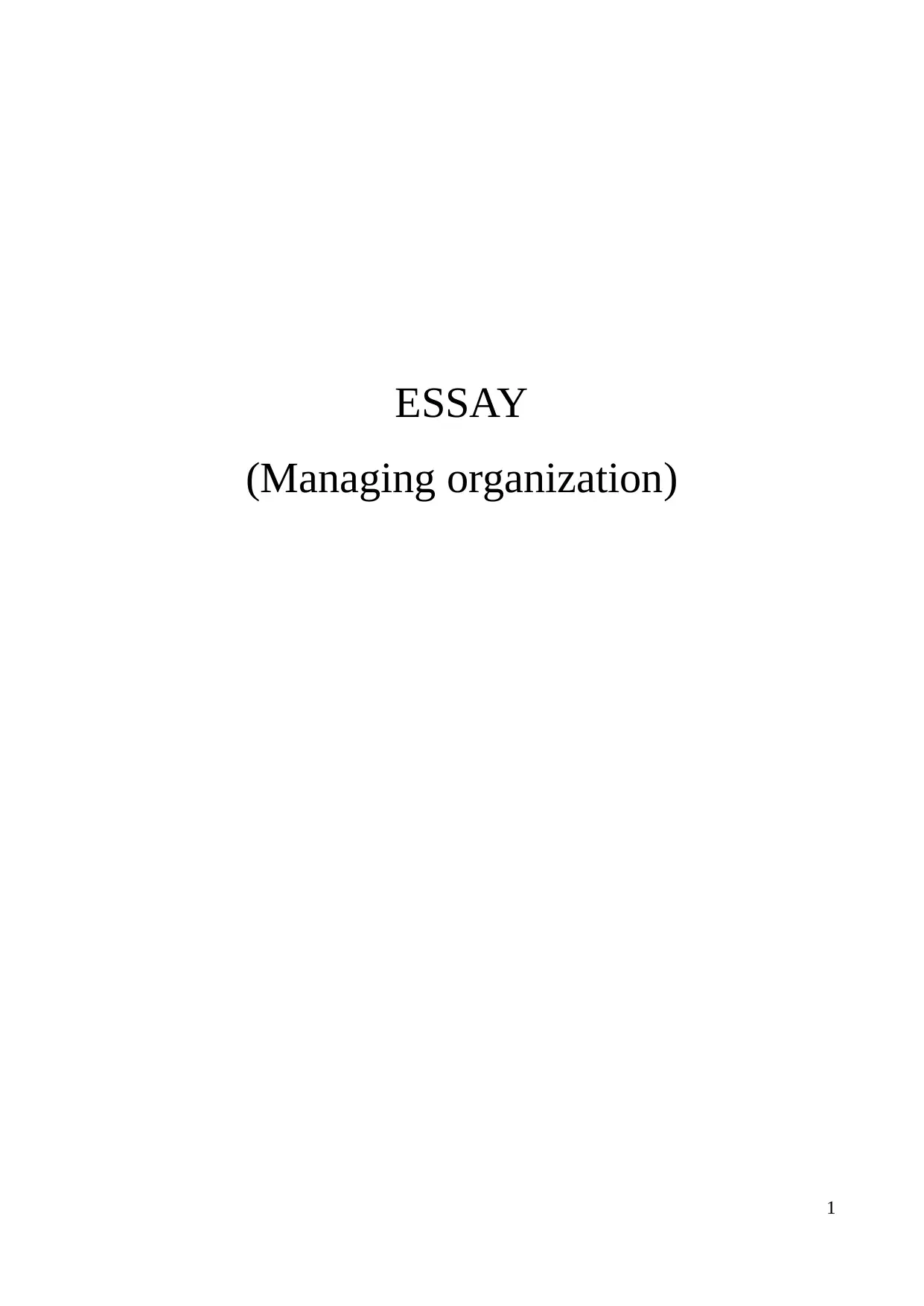
ESSAY
(Managing organization)
1
(Managing organization)
1
Paraphrase This Document
Need a fresh take? Get an instant paraphrase of this document with our AI Paraphraser

Table of Contents
INTRODUCTION................................................................................................................................3
TEAM DEVELOPMENT THEORIES AND ITS CRITICAL DISCUSSION....................................3
Tuckman’s group development theory, advantage and disadvantage..............................................4
Belbin’s team role theory, advantage and disadvantage..................................................................6
CONCLUSION....................................................................................................................................8
REFERENCES.....................................................................................................................................9
2
INTRODUCTION................................................................................................................................3
TEAM DEVELOPMENT THEORIES AND ITS CRITICAL DISCUSSION....................................3
Tuckman’s group development theory, advantage and disadvantage..............................................4
Belbin’s team role theory, advantage and disadvantage..................................................................6
CONCLUSION....................................................................................................................................8
REFERENCES.....................................................................................................................................9
2
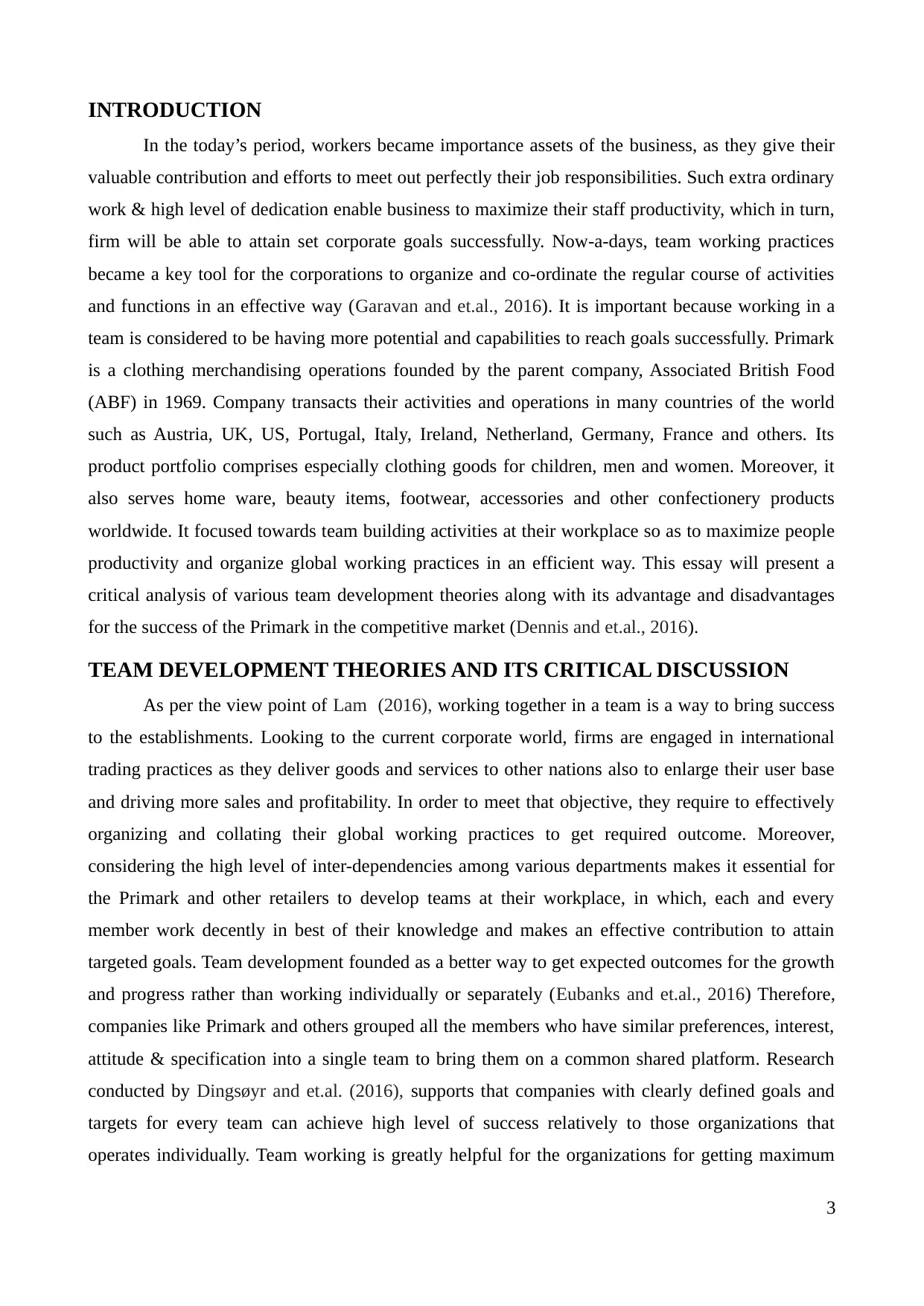
INTRODUCTION
In the today’s period, workers became importance assets of the business, as they give their
valuable contribution and efforts to meet out perfectly their job responsibilities. Such extra ordinary
work & high level of dedication enable business to maximize their staff productivity, which in turn,
firm will be able to attain set corporate goals successfully. Now-a-days, team working practices
became a key tool for the corporations to organize and co-ordinate the regular course of activities
and functions in an effective way (Garavan and et.al., 2016). It is important because working in a
team is considered to be having more potential and capabilities to reach goals successfully. Primark
is a clothing merchandising operations founded by the parent company, Associated British Food
(ABF) in 1969. Company transacts their activities and operations in many countries of the world
such as Austria, UK, US, Portugal, Italy, Ireland, Netherland, Germany, France and others. Its
product portfolio comprises especially clothing goods for children, men and women. Moreover, it
also serves home ware, beauty items, footwear, accessories and other confectionery products
worldwide. It focused towards team building activities at their workplace so as to maximize people
productivity and organize global working practices in an efficient way. This essay will present a
critical analysis of various team development theories along with its advantage and disadvantages
for the success of the Primark in the competitive market (Dennis and et.al., 2016).
TEAM DEVELOPMENT THEORIES AND ITS CRITICAL DISCUSSION
As per the view point of Lam (2016), working together in a team is a way to bring success
to the establishments. Looking to the current corporate world, firms are engaged in international
trading practices as they deliver goods and services to other nations also to enlarge their user base
and driving more sales and profitability. In order to meet that objective, they require to effectively
organizing and collating their global working practices to get required outcome. Moreover,
considering the high level of inter-dependencies among various departments makes it essential for
the Primark and other retailers to develop teams at their workplace, in which, each and every
member work decently in best of their knowledge and makes an effective contribution to attain
targeted goals. Team development founded as a better way to get expected outcomes for the growth
and progress rather than working individually or separately (Eubanks and et.al., 2016) Therefore,
companies like Primark and others grouped all the members who have similar preferences, interest,
attitude & specification into a single team to bring them on a common shared platform. Research
conducted by Dingsøyr and et.al. (2016), supports that companies with clearly defined goals and
targets for every team can achieve high level of success relatively to those organizations that
operates individually. Team working is greatly helpful for the organizations for getting maximum
3
In the today’s period, workers became importance assets of the business, as they give their
valuable contribution and efforts to meet out perfectly their job responsibilities. Such extra ordinary
work & high level of dedication enable business to maximize their staff productivity, which in turn,
firm will be able to attain set corporate goals successfully. Now-a-days, team working practices
became a key tool for the corporations to organize and co-ordinate the regular course of activities
and functions in an effective way (Garavan and et.al., 2016). It is important because working in a
team is considered to be having more potential and capabilities to reach goals successfully. Primark
is a clothing merchandising operations founded by the parent company, Associated British Food
(ABF) in 1969. Company transacts their activities and operations in many countries of the world
such as Austria, UK, US, Portugal, Italy, Ireland, Netherland, Germany, France and others. Its
product portfolio comprises especially clothing goods for children, men and women. Moreover, it
also serves home ware, beauty items, footwear, accessories and other confectionery products
worldwide. It focused towards team building activities at their workplace so as to maximize people
productivity and organize global working practices in an efficient way. This essay will present a
critical analysis of various team development theories along with its advantage and disadvantages
for the success of the Primark in the competitive market (Dennis and et.al., 2016).
TEAM DEVELOPMENT THEORIES AND ITS CRITICAL DISCUSSION
As per the view point of Lam (2016), working together in a team is a way to bring success
to the establishments. Looking to the current corporate world, firms are engaged in international
trading practices as they deliver goods and services to other nations also to enlarge their user base
and driving more sales and profitability. In order to meet that objective, they require to effectively
organizing and collating their global working practices to get required outcome. Moreover,
considering the high level of inter-dependencies among various departments makes it essential for
the Primark and other retailers to develop teams at their workplace, in which, each and every
member work decently in best of their knowledge and makes an effective contribution to attain
targeted goals. Team development founded as a better way to get expected outcomes for the growth
and progress rather than working individually or separately (Eubanks and et.al., 2016) Therefore,
companies like Primark and others grouped all the members who have similar preferences, interest,
attitude & specification into a single team to bring them on a common shared platform. Research
conducted by Dingsøyr and et.al. (2016), supports that companies with clearly defined goals and
targets for every team can achieve high level of success relatively to those organizations that
operates individually. Team working is greatly helpful for the organizations for getting maximum
3
⊘ This is a preview!⊘
Do you want full access?
Subscribe today to unlock all pages.

Trusted by 1+ million students worldwide
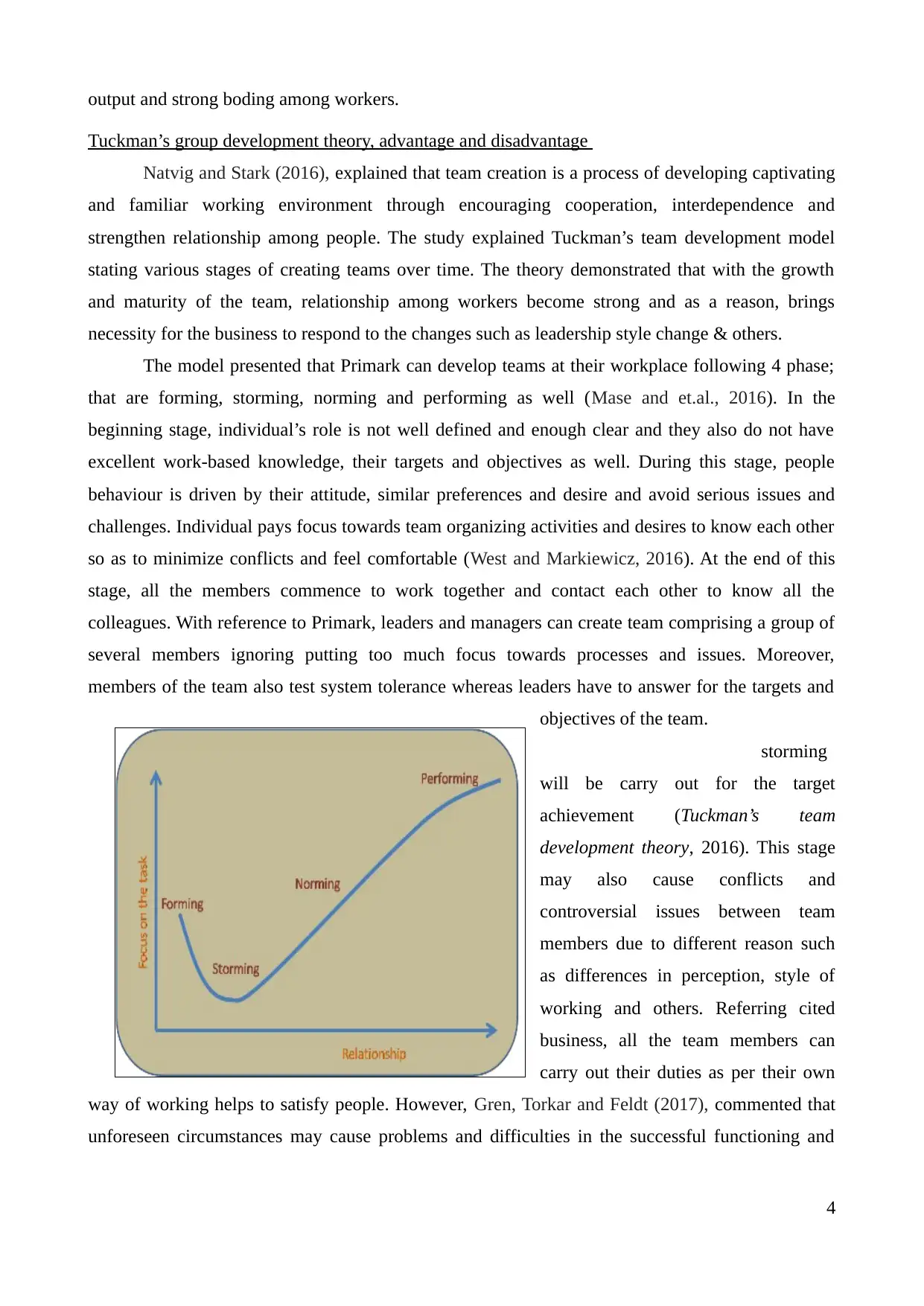
output and strong boding among workers.
Tuckman’s group development theory, advantage and disadvantage
Natvig and Stark (2016), explained that team creation is a process of developing captivating
and familiar working environment through encouraging cooperation, interdependence and
strengthen relationship among people. The study explained Tuckman’s team development model
stating various stages of creating teams over time. The theory demonstrated that with the growth
and maturity of the team, relationship among workers become strong and as a reason, brings
necessity for the business to respond to the changes such as leadership style change & others.
The model presented that Primark can develop teams at their workplace following 4 phase;
that are forming, storming, norming and performing as well (Mase and et.al., 2016). In the
beginning stage, individual’s role is not well defined and enough clear and they also do not have
excellent work-based knowledge, their targets and objectives as well. During this stage, people
behaviour is driven by their attitude, similar preferences and desire and avoid serious issues and
challenges. Individual pays focus towards team organizing activities and desires to know each other
so as to minimize conflicts and feel comfortable (West and Markiewicz, 2016). At the end of this
stage, all the members commence to work together and contact each other to know all the
colleagues. With reference to Primark, leaders and managers can create team comprising a group of
several members ignoring putting too much focus towards processes and issues. Moreover,
members of the team also test system tolerance whereas leaders have to answer for the targets and
objectives of the team.
After that, storming
will be carry out for the target
achievement (Tuckman’s team
development theory, 2016). This stage
may also cause conflicts and
controversial issues between team
members due to different reason such
as differences in perception, style of
working and others. Referring cited
business, all the team members can
carry out their duties as per their own
way of working helps to satisfy people. However, Gren, Torkar and Feldt (2017), commented that
unforeseen circumstances may cause problems and difficulties in the successful functioning and
4
Tuckman’s group development theory, advantage and disadvantage
Natvig and Stark (2016), explained that team creation is a process of developing captivating
and familiar working environment through encouraging cooperation, interdependence and
strengthen relationship among people. The study explained Tuckman’s team development model
stating various stages of creating teams over time. The theory demonstrated that with the growth
and maturity of the team, relationship among workers become strong and as a reason, brings
necessity for the business to respond to the changes such as leadership style change & others.
The model presented that Primark can develop teams at their workplace following 4 phase;
that are forming, storming, norming and performing as well (Mase and et.al., 2016). In the
beginning stage, individual’s role is not well defined and enough clear and they also do not have
excellent work-based knowledge, their targets and objectives as well. During this stage, people
behaviour is driven by their attitude, similar preferences and desire and avoid serious issues and
challenges. Individual pays focus towards team organizing activities and desires to know each other
so as to minimize conflicts and feel comfortable (West and Markiewicz, 2016). At the end of this
stage, all the members commence to work together and contact each other to know all the
colleagues. With reference to Primark, leaders and managers can create team comprising a group of
several members ignoring putting too much focus towards processes and issues. Moreover,
members of the team also test system tolerance whereas leaders have to answer for the targets and
objectives of the team.
After that, storming
will be carry out for the target
achievement (Tuckman’s team
development theory, 2016). This stage
may also cause conflicts and
controversial issues between team
members due to different reason such
as differences in perception, style of
working and others. Referring cited
business, all the team members can
carry out their duties as per their own
way of working helps to satisfy people. However, Gren, Torkar and Feldt (2017), commented that
unforeseen circumstances may cause problems and difficulties in the successful functioning and
4
Paraphrase This Document
Need a fresh take? Get an instant paraphrase of this document with our AI Paraphraser
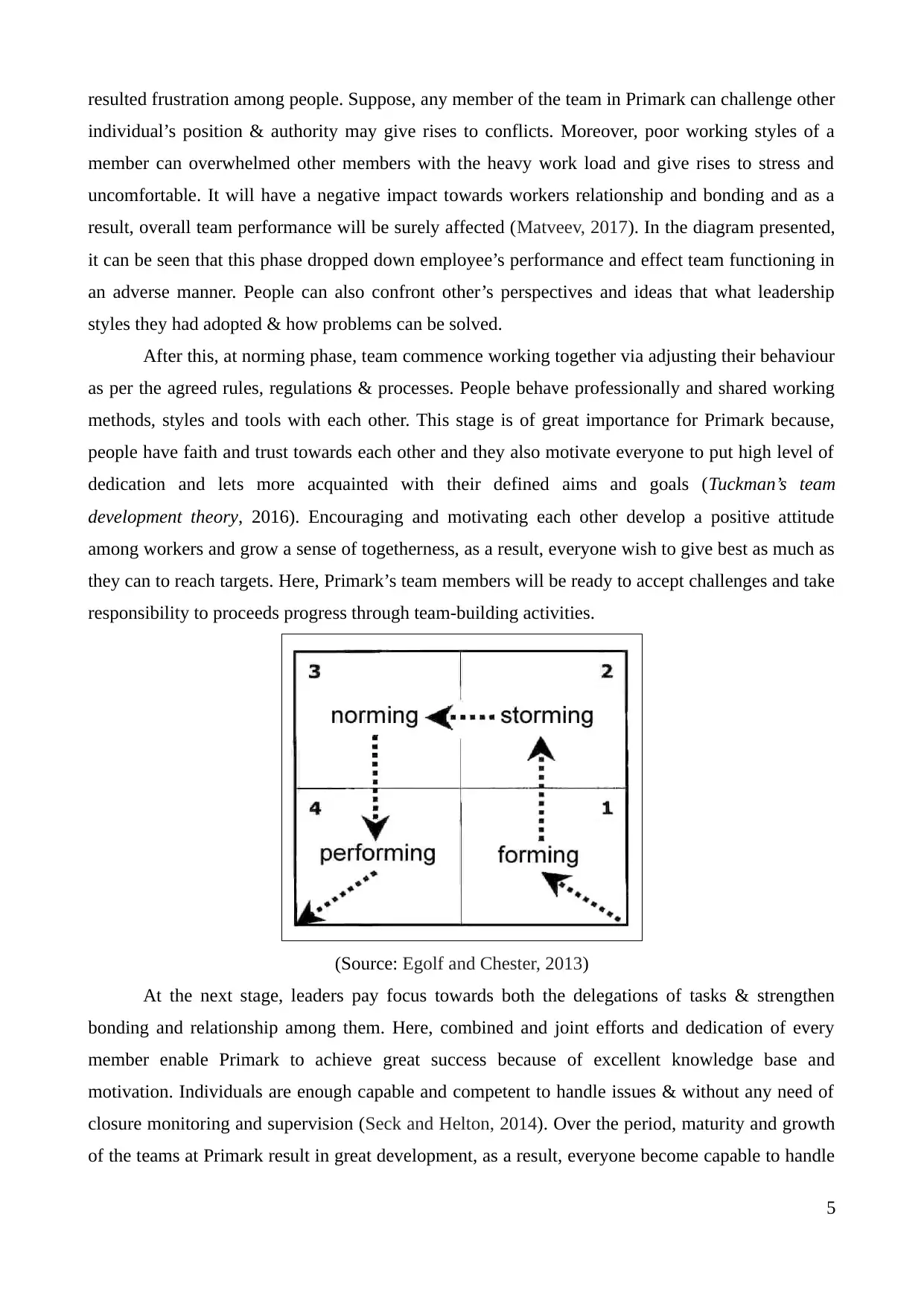
resulted frustration among people. Suppose, any member of the team in Primark can challenge other
individual’s position & authority may give rises to conflicts. Moreover, poor working styles of a
member can overwhelmed other members with the heavy work load and give rises to stress and
uncomfortable. It will have a negative impact towards workers relationship and bonding and as a
result, overall team performance will be surely affected (Matveev, 2017). In the diagram presented,
it can be seen that this phase dropped down employee’s performance and effect team functioning in
an adverse manner. People can also confront other’s perspectives and ideas that what leadership
styles they had adopted & how problems can be solved.
After this, at norming phase, team commence working together via adjusting their behaviour
as per the agreed rules, regulations & processes. People behave professionally and shared working
methods, styles and tools with each other. This stage is of great importance for Primark because,
people have faith and trust towards each other and they also motivate everyone to put high level of
dedication and lets more acquainted with their defined aims and goals (Tuckman’s team
development theory, 2016). Encouraging and motivating each other develop a positive attitude
among workers and grow a sense of togetherness, as a result, everyone wish to give best as much as
they can to reach targets. Here, Primark’s team members will be ready to accept challenges and take
responsibility to proceeds progress through team-building activities.
(Source: Egolf and Chester, 2013)
At the next stage, leaders pay focus towards both the delegations of tasks & strengthen
bonding and relationship among them. Here, combined and joint efforts and dedication of every
member enable Primark to achieve great success because of excellent knowledge base and
motivation. Individuals are enough capable and competent to handle issues & without any need of
closure monitoring and supervision (Seck and Helton, 2014). Over the period, maturity and growth
of the teams at Primark result in great development, as a result, everyone become capable to handle
5
individual’s position & authority may give rises to conflicts. Moreover, poor working styles of a
member can overwhelmed other members with the heavy work load and give rises to stress and
uncomfortable. It will have a negative impact towards workers relationship and bonding and as a
result, overall team performance will be surely affected (Matveev, 2017). In the diagram presented,
it can be seen that this phase dropped down employee’s performance and effect team functioning in
an adverse manner. People can also confront other’s perspectives and ideas that what leadership
styles they had adopted & how problems can be solved.
After this, at norming phase, team commence working together via adjusting their behaviour
as per the agreed rules, regulations & processes. People behave professionally and shared working
methods, styles and tools with each other. This stage is of great importance for Primark because,
people have faith and trust towards each other and they also motivate everyone to put high level of
dedication and lets more acquainted with their defined aims and goals (Tuckman’s team
development theory, 2016). Encouraging and motivating each other develop a positive attitude
among workers and grow a sense of togetherness, as a result, everyone wish to give best as much as
they can to reach targets. Here, Primark’s team members will be ready to accept challenges and take
responsibility to proceeds progress through team-building activities.
(Source: Egolf and Chester, 2013)
At the next stage, leaders pay focus towards both the delegations of tasks & strengthen
bonding and relationship among them. Here, combined and joint efforts and dedication of every
member enable Primark to achieve great success because of excellent knowledge base and
motivation. Individuals are enough capable and competent to handle issues & without any need of
closure monitoring and supervision (Seck and Helton, 2014). Over the period, maturity and growth
of the teams at Primark result in great development, as a result, everyone become capable to handle
5
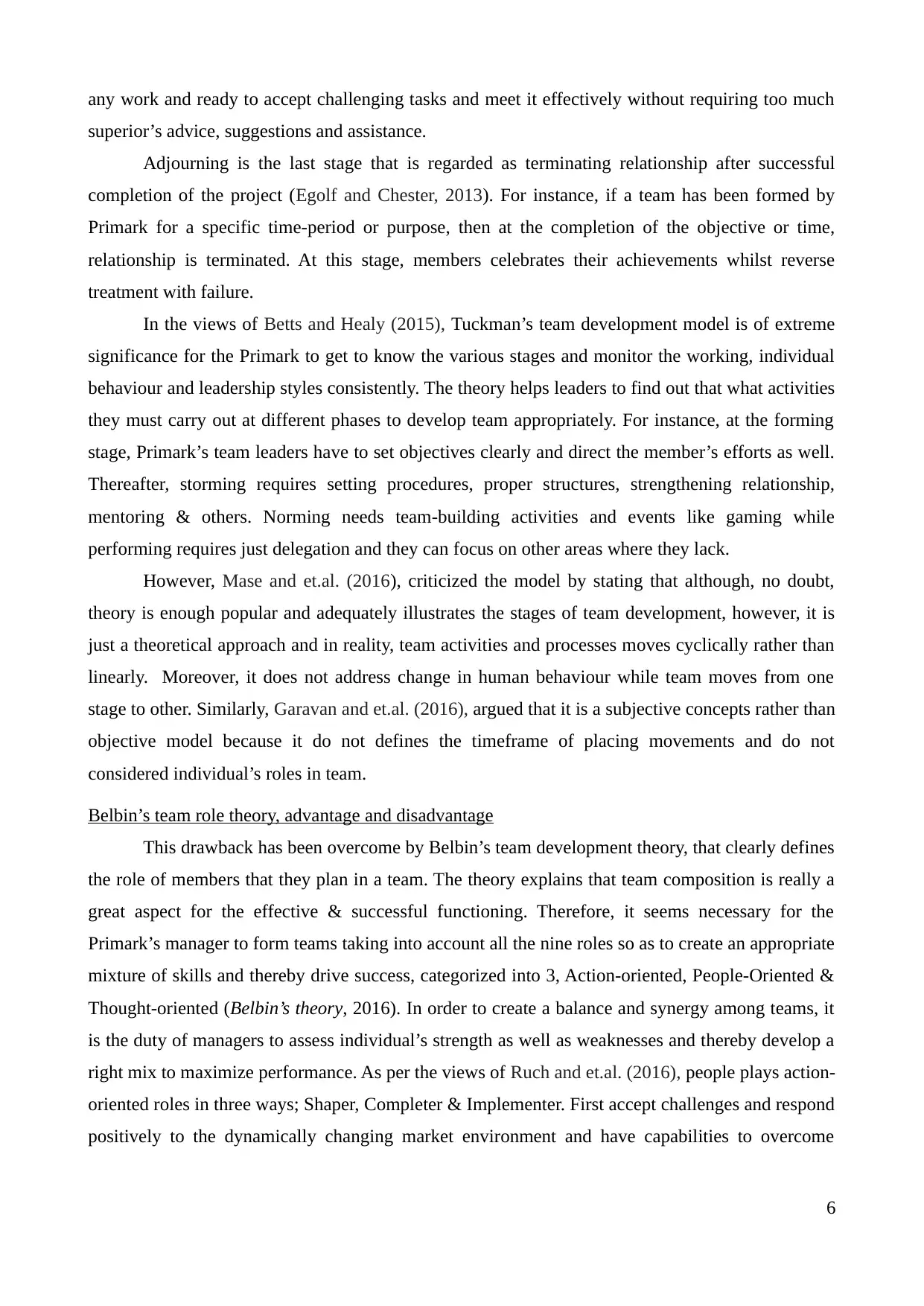
any work and ready to accept challenging tasks and meet it effectively without requiring too much
superior’s advice, suggestions and assistance.
Adjourning is the last stage that is regarded as terminating relationship after successful
completion of the project (Egolf and Chester, 2013). For instance, if a team has been formed by
Primark for a specific time-period or purpose, then at the completion of the objective or time,
relationship is terminated. At this stage, members celebrates their achievements whilst reverse
treatment with failure.
In the views of Betts and Healy (2015), Tuckman’s team development model is of extreme
significance for the Primark to get to know the various stages and monitor the working, individual
behaviour and leadership styles consistently. The theory helps leaders to find out that what activities
they must carry out at different phases to develop team appropriately. For instance, at the forming
stage, Primark’s team leaders have to set objectives clearly and direct the member’s efforts as well.
Thereafter, storming requires setting procedures, proper structures, strengthening relationship,
mentoring & others. Norming needs team-building activities and events like gaming while
performing requires just delegation and they can focus on other areas where they lack.
However, Mase and et.al. (2016), criticized the model by stating that although, no doubt,
theory is enough popular and adequately illustrates the stages of team development, however, it is
just a theoretical approach and in reality, team activities and processes moves cyclically rather than
linearly. Moreover, it does not address change in human behaviour while team moves from one
stage to other. Similarly, Garavan and et.al. (2016), argued that it is a subjective concepts rather than
objective model because it do not defines the timeframe of placing movements and do not
considered individual’s roles in team.
Belbin’s team role theory, advantage and disadvantage
This drawback has been overcome by Belbin’s team development theory, that clearly defines
the role of members that they plan in a team. The theory explains that team composition is really a
great aspect for the effective & successful functioning. Therefore, it seems necessary for the
Primark’s manager to form teams taking into account all the nine roles so as to create an appropriate
mixture of skills and thereby drive success, categorized into 3, Action-oriented, People-Oriented &
Thought-oriented (Belbin’s theory, 2016). In order to create a balance and synergy among teams, it
is the duty of managers to assess individual’s strength as well as weaknesses and thereby develop a
right mix to maximize performance. As per the views of Ruch and et.al. (2016), people plays action-
oriented roles in three ways; Shaper, Completer & Implementer. First accept challenges and respond
positively to the dynamically changing market environment and have capabilities to overcome
6
superior’s advice, suggestions and assistance.
Adjourning is the last stage that is regarded as terminating relationship after successful
completion of the project (Egolf and Chester, 2013). For instance, if a team has been formed by
Primark for a specific time-period or purpose, then at the completion of the objective or time,
relationship is terminated. At this stage, members celebrates their achievements whilst reverse
treatment with failure.
In the views of Betts and Healy (2015), Tuckman’s team development model is of extreme
significance for the Primark to get to know the various stages and monitor the working, individual
behaviour and leadership styles consistently. The theory helps leaders to find out that what activities
they must carry out at different phases to develop team appropriately. For instance, at the forming
stage, Primark’s team leaders have to set objectives clearly and direct the member’s efforts as well.
Thereafter, storming requires setting procedures, proper structures, strengthening relationship,
mentoring & others. Norming needs team-building activities and events like gaming while
performing requires just delegation and they can focus on other areas where they lack.
However, Mase and et.al. (2016), criticized the model by stating that although, no doubt,
theory is enough popular and adequately illustrates the stages of team development, however, it is
just a theoretical approach and in reality, team activities and processes moves cyclically rather than
linearly. Moreover, it does not address change in human behaviour while team moves from one
stage to other. Similarly, Garavan and et.al. (2016), argued that it is a subjective concepts rather than
objective model because it do not defines the timeframe of placing movements and do not
considered individual’s roles in team.
Belbin’s team role theory, advantage and disadvantage
This drawback has been overcome by Belbin’s team development theory, that clearly defines
the role of members that they plan in a team. The theory explains that team composition is really a
great aspect for the effective & successful functioning. Therefore, it seems necessary for the
Primark’s manager to form teams taking into account all the nine roles so as to create an appropriate
mixture of skills and thereby drive success, categorized into 3, Action-oriented, People-Oriented &
Thought-oriented (Belbin’s theory, 2016). In order to create a balance and synergy among teams, it
is the duty of managers to assess individual’s strength as well as weaknesses and thereby develop a
right mix to maximize performance. As per the views of Ruch and et.al. (2016), people plays action-
oriented roles in three ways; Shaper, Completer & Implementer. First accept challenges and respond
positively to the dynamically changing market environment and have capabilities to overcome
6
⊘ This is a preview!⊘
Do you want full access?
Subscribe today to unlock all pages.

Trusted by 1+ million students worldwide
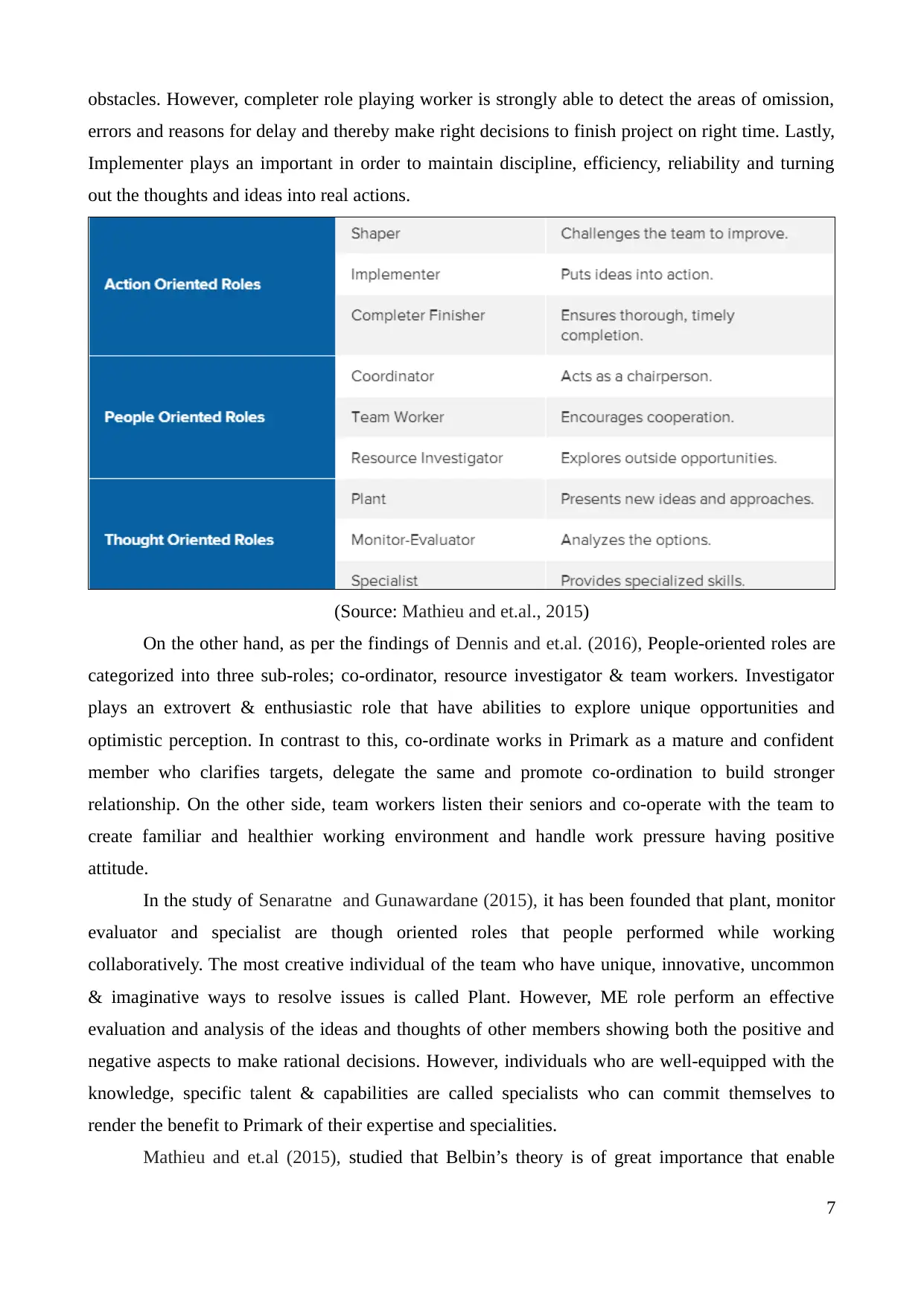
obstacles. However, completer role playing worker is strongly able to detect the areas of omission,
errors and reasons for delay and thereby make right decisions to finish project on right time. Lastly,
Implementer plays an important in order to maintain discipline, efficiency, reliability and turning
out the thoughts and ideas into real actions.
(Source: Mathieu and et.al., 2015)
On the other hand, as per the findings of Dennis and et.al. (2016), People-oriented roles are
categorized into three sub-roles; co-ordinator, resource investigator & team workers. Investigator
plays an extrovert & enthusiastic role that have abilities to explore unique opportunities and
optimistic perception. In contrast to this, co-ordinate works in Primark as a mature and confident
member who clarifies targets, delegate the same and promote co-ordination to build stronger
relationship. On the other side, team workers listen their seniors and co-operate with the team to
create familiar and healthier working environment and handle work pressure having positive
attitude.
In the study of Senaratne and Gunawardane (2015), it has been founded that plant, monitor
evaluator and specialist are though oriented roles that people performed while working
collaboratively. The most creative individual of the team who have unique, innovative, uncommon
& imaginative ways to resolve issues is called Plant. However, ME role perform an effective
evaluation and analysis of the ideas and thoughts of other members showing both the positive and
negative aspects to make rational decisions. However, individuals who are well-equipped with the
knowledge, specific talent & capabilities are called specialists who can commit themselves to
render the benefit to Primark of their expertise and specialities.
Mathieu and et.al (2015), studied that Belbin’s theory is of great importance that enable
7
errors and reasons for delay and thereby make right decisions to finish project on right time. Lastly,
Implementer plays an important in order to maintain discipline, efficiency, reliability and turning
out the thoughts and ideas into real actions.
(Source: Mathieu and et.al., 2015)
On the other hand, as per the findings of Dennis and et.al. (2016), People-oriented roles are
categorized into three sub-roles; co-ordinator, resource investigator & team workers. Investigator
plays an extrovert & enthusiastic role that have abilities to explore unique opportunities and
optimistic perception. In contrast to this, co-ordinate works in Primark as a mature and confident
member who clarifies targets, delegate the same and promote co-ordination to build stronger
relationship. On the other side, team workers listen their seniors and co-operate with the team to
create familiar and healthier working environment and handle work pressure having positive
attitude.
In the study of Senaratne and Gunawardane (2015), it has been founded that plant, monitor
evaluator and specialist are though oriented roles that people performed while working
collaboratively. The most creative individual of the team who have unique, innovative, uncommon
& imaginative ways to resolve issues is called Plant. However, ME role perform an effective
evaluation and analysis of the ideas and thoughts of other members showing both the positive and
negative aspects to make rational decisions. However, individuals who are well-equipped with the
knowledge, specific talent & capabilities are called specialists who can commit themselves to
render the benefit to Primark of their expertise and specialities.
Mathieu and et.al (2015), studied that Belbin’s theory is of great importance that enable
7
Paraphrase This Document
Need a fresh take? Get an instant paraphrase of this document with our AI Paraphraser
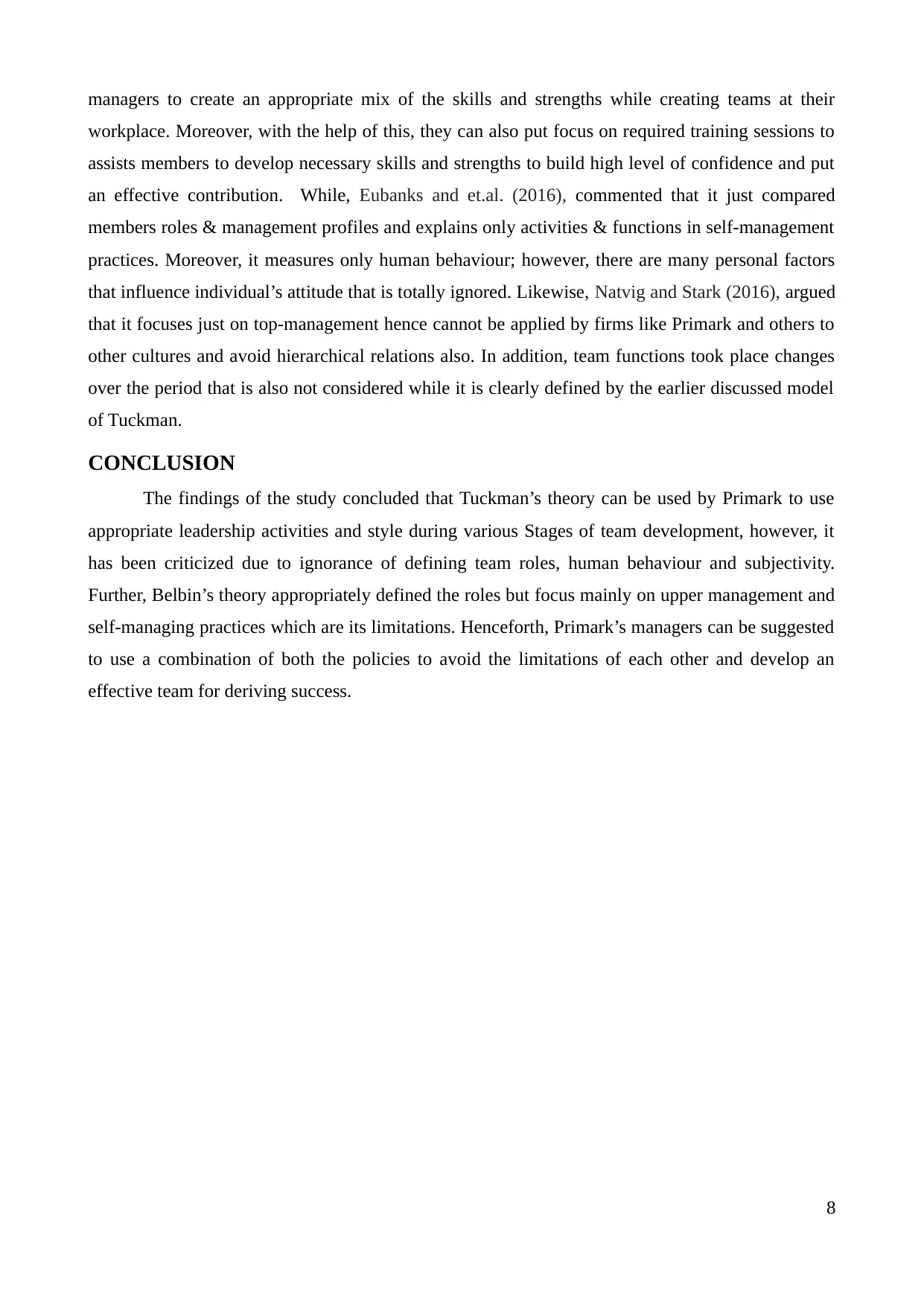
managers to create an appropriate mix of the skills and strengths while creating teams at their
workplace. Moreover, with the help of this, they can also put focus on required training sessions to
assists members to develop necessary skills and strengths to build high level of confidence and put
an effective contribution. While, Eubanks and et.al. (2016), commented that it just compared
members roles & management profiles and explains only activities & functions in self-management
practices. Moreover, it measures only human behaviour; however, there are many personal factors
that influence individual’s attitude that is totally ignored. Likewise, Natvig and Stark (2016), argued
that it focuses just on top-management hence cannot be applied by firms like Primark and others to
other cultures and avoid hierarchical relations also. In addition, team functions took place changes
over the period that is also not considered while it is clearly defined by the earlier discussed model
of Tuckman.
CONCLUSION
The findings of the study concluded that Tuckman’s theory can be used by Primark to use
appropriate leadership activities and style during various Stages of team development, however, it
has been criticized due to ignorance of defining team roles, human behaviour and subjectivity.
Further, Belbin’s theory appropriately defined the roles but focus mainly on upper management and
self-managing practices which are its limitations. Henceforth, Primark’s managers can be suggested
to use a combination of both the policies to avoid the limitations of each other and develop an
effective team for deriving success.
8
workplace. Moreover, with the help of this, they can also put focus on required training sessions to
assists members to develop necessary skills and strengths to build high level of confidence and put
an effective contribution. While, Eubanks and et.al. (2016), commented that it just compared
members roles & management profiles and explains only activities & functions in self-management
practices. Moreover, it measures only human behaviour; however, there are many personal factors
that influence individual’s attitude that is totally ignored. Likewise, Natvig and Stark (2016), argued
that it focuses just on top-management hence cannot be applied by firms like Primark and others to
other cultures and avoid hierarchical relations also. In addition, team functions took place changes
over the period that is also not considered while it is clearly defined by the earlier discussed model
of Tuckman.
CONCLUSION
The findings of the study concluded that Tuckman’s theory can be used by Primark to use
appropriate leadership activities and style during various Stages of team development, however, it
has been criticized due to ignorance of defining team roles, human behaviour and subjectivity.
Further, Belbin’s theory appropriately defined the roles but focus mainly on upper management and
self-managing practices which are its limitations. Henceforth, Primark’s managers can be suggested
to use a combination of both the policies to avoid the limitations of each other and develop an
effective team for deriving success.
8
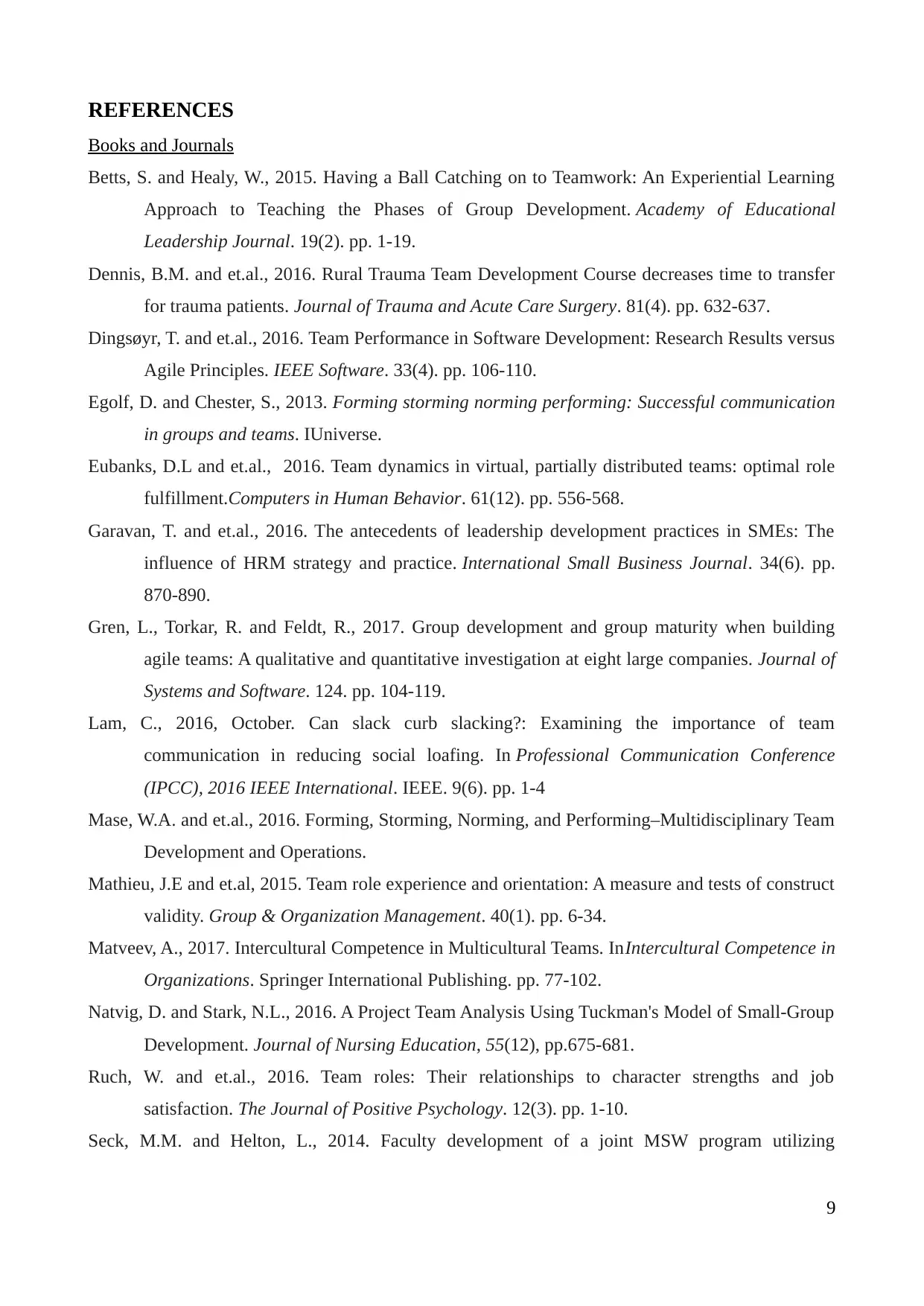
REFERENCES
Books and Journals
Betts, S. and Healy, W., 2015. Having a Ball Catching on to Teamwork: An Experiential Learning
Approach to Teaching the Phases of Group Development. Academy of Educational
Leadership Journal. 19(2). pp. 1-19.
Dennis, B.M. and et.al., 2016. Rural Trauma Team Development Course decreases time to transfer
for trauma patients. Journal of Trauma and Acute Care Surgery. 81(4). pp. 632-637.
Dingsøyr, T. and et.al., 2016. Team Performance in Software Development: Research Results versus
Agile Principles. IEEE Software. 33(4). pp. 106-110.
Egolf, D. and Chester, S., 2013. Forming storming norming performing: Successful communication
in groups and teams. IUniverse.
Eubanks, D.L and et.al., 2016. Team dynamics in virtual, partially distributed teams: optimal role
fulfillment.Computers in Human Behavior. 61(12). pp. 556-568.
Garavan, T. and et.al., 2016. The antecedents of leadership development practices in SMEs: The
influence of HRM strategy and practice. International Small Business Journal. 34(6). pp.
870-890.
Gren, L., Torkar, R. and Feldt, R., 2017. Group development and group maturity when building
agile teams: A qualitative and quantitative investigation at eight large companies. Journal of
Systems and Software. 124. pp. 104-119.
Lam, C., 2016, October. Can slack curb slacking?: Examining the importance of team
communication in reducing social loafing. In Professional Communication Conference
(IPCC), 2016 IEEE International. IEEE. 9(6). pp. 1-4
Mase, W.A. and et.al., 2016. Forming, Storming, Norming, and Performing–Multidisciplinary Team
Development and Operations.
Mathieu, J.E and et.al, 2015. Team role experience and orientation: A measure and tests of construct
validity. Group & Organization Management. 40(1). pp. 6-34.
Matveev, A., 2017. Intercultural Competence in Multicultural Teams. InIntercultural Competence in
Organizations. Springer International Publishing. pp. 77-102.
Natvig, D. and Stark, N.L., 2016. A Project Team Analysis Using Tuckman's Model of Small-Group
Development. Journal of Nursing Education, 55(12), pp.675-681.
Ruch, W. and et.al., 2016. Team roles: Their relationships to character strengths and job
satisfaction. The Journal of Positive Psychology. 12(3). pp. 1-10.
Seck, M.M. and Helton, L., 2014. Faculty development of a joint MSW program utilizing
9
Books and Journals
Betts, S. and Healy, W., 2015. Having a Ball Catching on to Teamwork: An Experiential Learning
Approach to Teaching the Phases of Group Development. Academy of Educational
Leadership Journal. 19(2). pp. 1-19.
Dennis, B.M. and et.al., 2016. Rural Trauma Team Development Course decreases time to transfer
for trauma patients. Journal of Trauma and Acute Care Surgery. 81(4). pp. 632-637.
Dingsøyr, T. and et.al., 2016. Team Performance in Software Development: Research Results versus
Agile Principles. IEEE Software. 33(4). pp. 106-110.
Egolf, D. and Chester, S., 2013. Forming storming norming performing: Successful communication
in groups and teams. IUniverse.
Eubanks, D.L and et.al., 2016. Team dynamics in virtual, partially distributed teams: optimal role
fulfillment.Computers in Human Behavior. 61(12). pp. 556-568.
Garavan, T. and et.al., 2016. The antecedents of leadership development practices in SMEs: The
influence of HRM strategy and practice. International Small Business Journal. 34(6). pp.
870-890.
Gren, L., Torkar, R. and Feldt, R., 2017. Group development and group maturity when building
agile teams: A qualitative and quantitative investigation at eight large companies. Journal of
Systems and Software. 124. pp. 104-119.
Lam, C., 2016, October. Can slack curb slacking?: Examining the importance of team
communication in reducing social loafing. In Professional Communication Conference
(IPCC), 2016 IEEE International. IEEE. 9(6). pp. 1-4
Mase, W.A. and et.al., 2016. Forming, Storming, Norming, and Performing–Multidisciplinary Team
Development and Operations.
Mathieu, J.E and et.al, 2015. Team role experience and orientation: A measure and tests of construct
validity. Group & Organization Management. 40(1). pp. 6-34.
Matveev, A., 2017. Intercultural Competence in Multicultural Teams. InIntercultural Competence in
Organizations. Springer International Publishing. pp. 77-102.
Natvig, D. and Stark, N.L., 2016. A Project Team Analysis Using Tuckman's Model of Small-Group
Development. Journal of Nursing Education, 55(12), pp.675-681.
Ruch, W. and et.al., 2016. Team roles: Their relationships to character strengths and job
satisfaction. The Journal of Positive Psychology. 12(3). pp. 1-10.
Seck, M.M. and Helton, L., 2014. Faculty development of a joint MSW program utilizing
9
⊘ This is a preview!⊘
Do you want full access?
Subscribe today to unlock all pages.

Trusted by 1+ million students worldwide
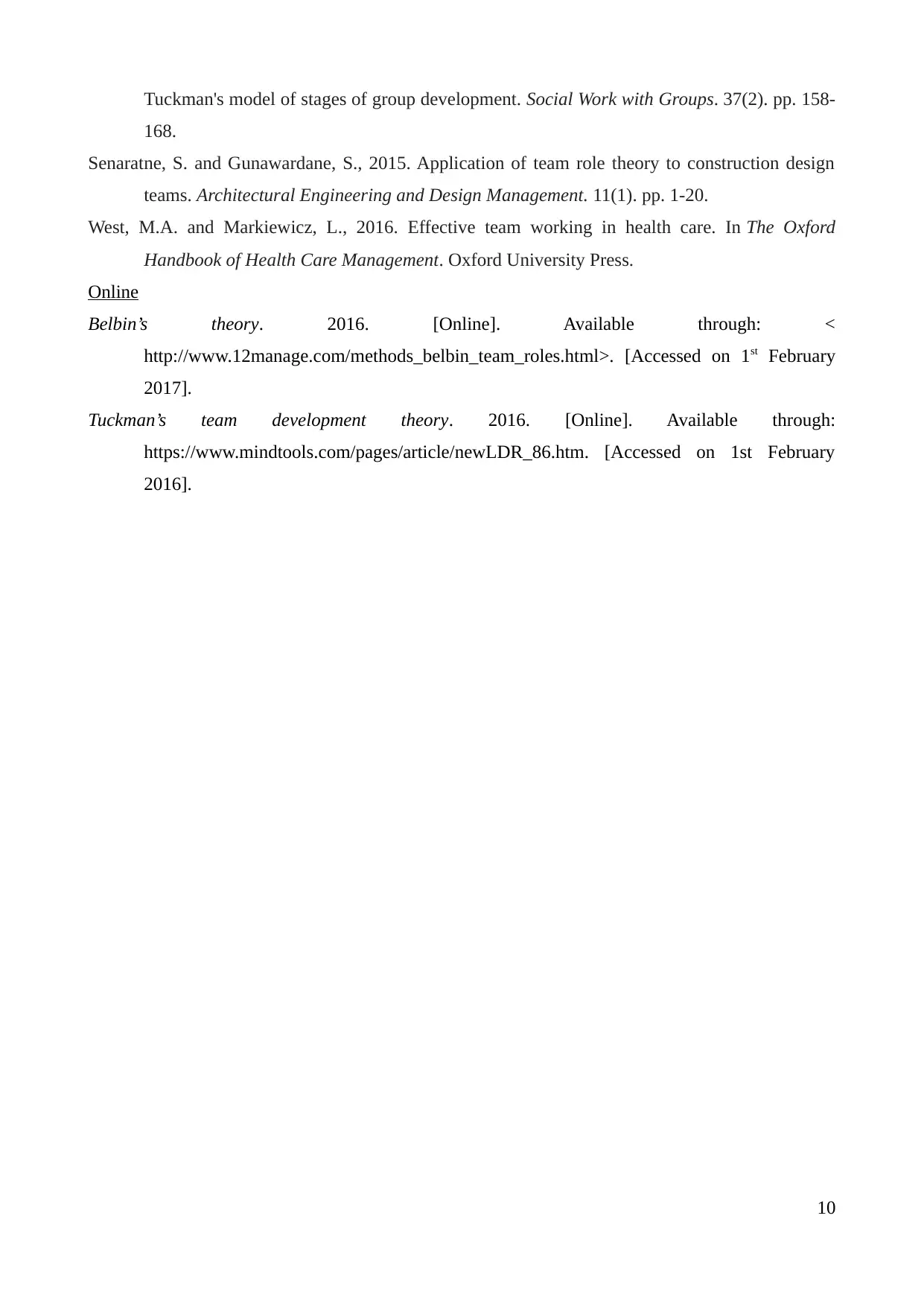
Tuckman's model of stages of group development. Social Work with Groups. 37(2). pp. 158-
168.
Senaratne, S. and Gunawardane, S., 2015. Application of team role theory to construction design
teams. Architectural Engineering and Design Management. 11(1). pp. 1-20.
West, M.A. and Markiewicz, L., 2016. Effective team working in health care. In The Oxford
Handbook of Health Care Management. Oxford University Press.
Online
Belbin’s theory. 2016. [Online]. Available through: <
http://www.12manage.com/methods_belbin_team_roles.html>. [Accessed on 1st February
2017].
Tuckman’s team development theory. 2016. [Online]. Available through:
https://www.mindtools.com/pages/article/newLDR_86.htm. [Accessed on 1st February
2016].
10
168.
Senaratne, S. and Gunawardane, S., 2015. Application of team role theory to construction design
teams. Architectural Engineering and Design Management. 11(1). pp. 1-20.
West, M.A. and Markiewicz, L., 2016. Effective team working in health care. In The Oxford
Handbook of Health Care Management. Oxford University Press.
Online
Belbin’s theory. 2016. [Online]. Available through: <
http://www.12manage.com/methods_belbin_team_roles.html>. [Accessed on 1st February
2017].
Tuckman’s team development theory. 2016. [Online]. Available through:
https://www.mindtools.com/pages/article/newLDR_86.htm. [Accessed on 1st February
2016].
10
1 out of 10
Related Documents
Your All-in-One AI-Powered Toolkit for Academic Success.
+13062052269
info@desklib.com
Available 24*7 on WhatsApp / Email
![[object Object]](/_next/static/media/star-bottom.7253800d.svg)
Unlock your academic potential
Copyright © 2020–2025 A2Z Services. All Rights Reserved. Developed and managed by ZUCOL.




